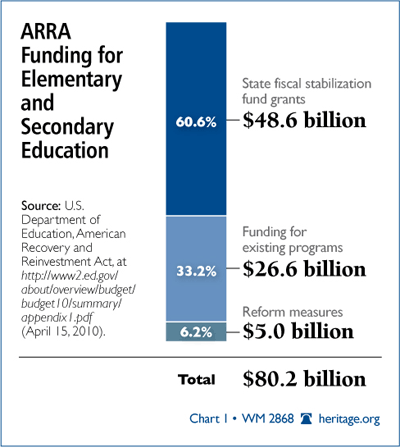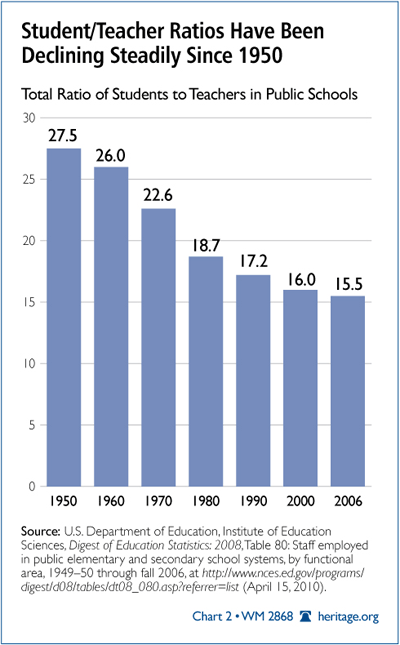The American Recovery and Reinvestment Act (ARRA), signed in February 2009, included nearly $100 billion in new funding for the Department of Education (DOE). Over $36 billion of it remains unspent, and bills in both the House and Senate are calling for even more funding for teacher jobs.
It is unlikely that billions more in federal spending will provide a long-term solution to state budget problems. Instead, such spending would prevent states from addressing fiscal problems, rethinking existing programs, and increasing efficiency.
ARRA Intentions: Preventing Job Losses and Spurring Reform
Preventing Job Losses and Backfilling State Budget Shortfalls. The primary goal of education funding in ARRA is to prevent job layoffs in the education sector.[1] Approximately 80 percent of the $100 billion from ARRA is reserved for K-12 education expenditures, and nearly all of that is designed to help states “recover” from budget shortfalls and prevent teacher layoffs.[2]

The ARRA was premised on the assumption that the U.S. needs to create new jobs or retain existing jobs in public education. But for decades the percentage of school staff dedicated to teaching has declined; more teachers are teaching fewer students. While student enrollment in elementary and secondary school has increased just 7 percent since 1970, public elementary and secondary staff enrollment has increased 83 percent.[3]

In some of the nation’s largest school systems, teaching and administrative staff has increased dramatically despite declines in student enrollment. From 2000 to 2009 for example, the New York City public school system added 11,114 new publicly funded hires, including both teachers and support staff—a 15 percent increase—despite enrollment declining by more than 62,000 students, or 6 percent.[4]
Trends since 1950 show that the percentage of teachers as a proportion of instructional staff has decreased dramatically. In 1950, 70.3 percent of elementary and secondary instructional staff was comprised of teachers; by 2006 that number had dropped to 51.6 percent. During the same period, support staff—which includes administrative support for schools and districts, library staff, and other support—increased from 23.8 percent to 29.9 percent.[5]
Budget shortfalls provided state leaders with an opportunity to rethink priorities and find ways of increasing efficiency,[6] such as online learning or tenure reform. Instead, the ARRA has been used to backfill state budget shortfalls. Unfortunately, some experts contend that “the ARRA may ultimately make future reforms more difficult to the extent they fund and therefore help sustain policies and practices antithetical to long-term improvement.”[7]
As of March 2010, $36.2 billion in ARRA education funding remains unspent.[8] Still, in April 2010, Senator Tom Harkin (D–IO) introduced the Keep Our Educators Working Act, which would provide $23 billion in additional funding to the DOE to create and maintain jobs in the education workforce. It is uncertain why an additional $23 billion is needed to create an “education jobs fund” when stimulus funding is still in the pipeline.
Encouraging the Obama Administration’s Vision for Reform. Of the $80 billion in ARRA funding reserved for K-12 education, $75 billion is meant to prevent job losses. The remaining $5 billion is intended to be leveraged by states to implement innovative education reforms. Over $4.35 billion of the funding designated for reform comprises the Race to the Top (RTTT) program, a competitive grant program designed to encourage states to implement the Administration’s education agenda.
In order to qualify for grants, states must commit to four key reforms outlined by the DOE:
- Adopting common core standards and assessments,
- Improving teacher quality,
- Turning around low-performing schools, and
- Implementing state data systems.
RTTT is intended to encourage states to implement promising reforms such as lifting caps on charter schools, creating performance pay for the most effective teachers, and providing alternative routes to teacher certification.[9]
While the Administration insisted that RTTT was created to spur significant changes among states, its performance to date raises questions about how robust the reforms will be.
- Charter caps. The two states that were awarded RTTT round 1 grants—Delaware and Tennessee—have pledged to lift caps on charter schools, but “not a single state prohibiting charter schools in early 2009 was able to leverage Race to the Top to pass a charter law,” reports Andy Smarick of the American Enterprise Institute.[10] And, despite winning a highly prized RTTT grant, Tennessee’s charter law still limits charters to 5 percent of all public schools in the state.[11] Meanwhile, Kentucky was one of the 15 finalist states even though it does not allow charter schools.[12]
- Performance pay for teachers. Many of the states that applied for a round 1 RTTT grant included proposals to implement performance pay for teachers, with some states pledging to make student test scores count for 50 percent of teachers’ performance evaluations.[13] Florida introduced a merit pay plan to base half of teachers’ performance grades on student test scores. Nevertheless, the Sunshine State did not receive an RTTT grant.
- Alternative teacher certification. The number of points a state could receive on its RTTT application for implementing alternative teacher certification was minimal in comparison to other application requirements. Only 21 points out of 500 points (4.2 percent) could be awarded for implementing pathways for aspiring teachers and principals.[14] The American Board for the Certification of Teacher Excellence, one of the only alternative teacher certification programs in the country, was included in only nine of 40 applications.
Union Buy-In?
The Administration claimed that reforms such as these would determine RTTT eligibility, but it appears union buy-in may have played a greater role than reform.
RTTT winners Delaware and Tennessee had nearly 100 percent union support for their grant applications, and the head of the teachers’ union in Delaware even came to Washington to make a pitch for the state’s RTTT proposal. At the same time, Florida, which had a robust reform plan, did not garner as much union support. One of the reviewers for Florida’s application stated, “The fact that only 8% of union leaders … endorsed the state’s application raises a concern about barriers. … The application does not address how the state will move forward assertively to generate union buy in.”[15]
Some analysts believe that union buy-in played a major role in awarding RTTT funds. “If people know that union opposition scuttles a state’s chances, then no state will apply in the future unless they have union support,” writes Professor Jay Greene of the University of Arkansas. “This means that the unions will dictate what reforms will be pursued, which means that there will be virtually no reform..”[16]
A Better Way to Spur Reform
The $100 billion allocated to the DOE through the ARRA effectively doubled the department’s budget over 2008 levels.[17] Compounding this figure, the Obama Administration’s FY 2011 budget further increases DOE outlays by 10 percent.
Instead of continuing to increase federal funding for education, policymakers should award states greater authority over how federal funds are spent. This flexibility will permit the innovative capacity of states to flourish and will encourage a true race to the top.
Lindsey M. Burke is a Policy Analyst in the Domestic Policy Studies Department at The Heritage Foundation.


